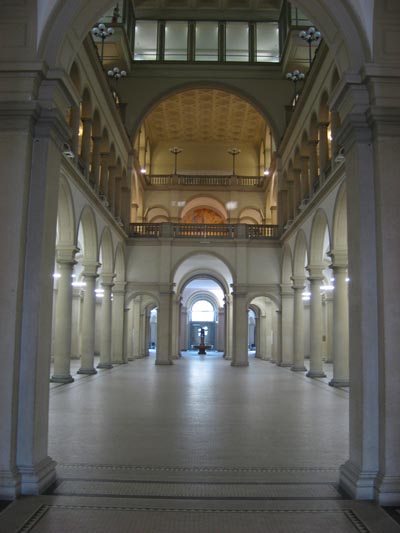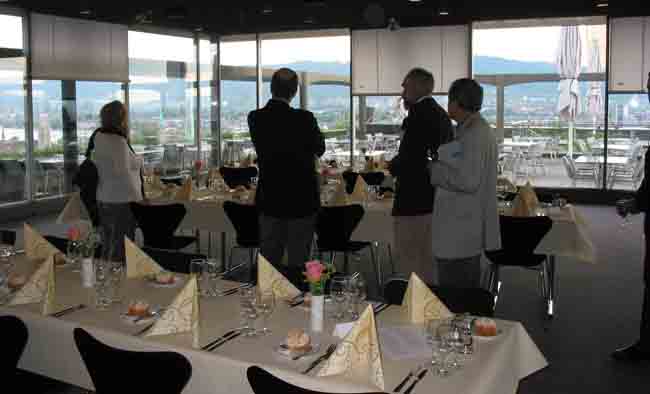
A Personal Perspective on the E.T.H. (Eidgenössische Technische Hochschule) in Zürich.
Background:




The Eidgenössische Technische Hochschule in Zürich is also known as the Swiss Federal Institute of Technology. It played a historic role in the development of physics, mathematics, and chemistry. The ghosts of Albert Einstein, Wolfgang Pauli, Hermann Weyl, Heinz Hopf, among many others roam the halls of this famous university.
The well-known 19th-century architect Gottfried Semper conceived the original buildings (Hauptgebaude) which frame the original campus near the center of the city. The central building has a left-right mirror symmetry. In the center there is an expansive open area extending up to the highest floor. The photo is taken during the term break, but during term it teams with people. It provides a favorite location for exhibits, posters, and even a student-built robot competition. Class room and offices go off on either side. The E.T.H. provides a familiar focus on the Zürich skyline and gives an attractive visual aspect to the city. During the year 2005, the E.T.H. celebrated the 150th anniversary of its founding.


Just next door to the Hauptgebaude lie the main old buildings of the University of Zürich, with the University Hospital across the street. The E.T.H. is a national institution, while the University is separate and under the authority of the local Canton of Zürich. Together these two neighboring universities perch side by side on the lower part of the Zürichberg, the hill that towers over downtown and the lake. One sees them as soon as you leave the main Zürich railway station (Hauptbahnhof). They follow the Universitätstrasse/Ramistrasse that leads down the hill to the Kunsthaus (city art museum) and the Niederdorf (old city).
From the Hauptgebaude one can wander downtown by foot to enjoy a coffee or a chocholate at Sprüngli on the Paradeplatz. One can contemplate on the terrace adjoining the Hauptgebaude where the student mensa provides good coffee. One can take a coffee in the Polysnack, where mathematicians sometimes hatch theorems or learn through accidental meetings about the latest new result. One can take the Polybahn funicular for a three-minute trip down to Central where one finds a better in the Café at the Hotel Schweizerhof. One can also wander to many places in the Niederdorf, such as the the Café Schober.



Or one can remain at the E.T.H. for lunch in the Dozentenfoyer (faculty club) on the top of the Hauptgebaude, with its magnificent panorama of the city, the lake, and—on clear days—of the mountains in the distance. A favorite place to work in the mid-afternoon is at one of the tables when the room is practically empty.

Some time ago, the E.T.H. "Seminar für Theoretische Physik" used to be housed at Hochstrasse 60 on the Zürichberg. That brick building that originally was a residence provided a home for Pauli, Jost, and Fierz. Now it has been transformed into an E.T.H. administrative building, with the offices for housing, security, the environment, etc.



The E.T.H. suffered a shortage of space downtown, and during the late 1960's the federal government planned and built the beginning of a second campus in the countryside. It is located on the Hönggerberg (over the old community of Höngg, now part of Zürich). As you drive up the hill, one sees a spectacular view of the city, although the view is hidden from the campus:

The theoretical physicists moved in 1971 into some of the first buildings on the Hönggerberg, along with many other departments. But the mathematicians preferred to remain downtown in the Hauptgebaude. The University of Zürich also found they needed more space. So the University created its own new campus in a third location. For various reasons there was no way to coordinate these plans, so the university constructed their new buildings in Irchel, midway between Hönggerberg and downtown. So today instead of one focus of activity, there on three foci.
Having distinct E.T.H. campuses makes academic life in Zürich less centralized than when I first visited the E.T.H. in 1968. At that time the older downtown buildings and the University were located just a few minutes away from each other by foot. But today mathematical physics is carried out today by three groups in Zürich. Klaus Hepp, Jürg Fröhlich, Gian-Michele Graf, and Matthias Gaberdiel spend most of their time in the theoretical physics building (named HPZ) on the Hönggerberg; Giovanni Felder, Oscar Lanford, and Eugene Trubowitz live in the mathematics department in the main downtown building—not to mention Konrad Osterwalder who became a very successful Rektor of the E.T.H. ( I wish he had time to finish some projects he began before his election as Rektor.) A third group of mathematical physicists works at the Irchel campus of the University, both in mathematics and in physics.
The mathematics department also houses the F.I.M. (Forschungsinstitut für Mathematik) which arrances a large number of visitors who collaborate with local mathematicians on research projects. The F.I.M. occasionally also holds conferences. For instance, in 2004 they celebrated their anniversary with a large meeting. Then a very interesting meeting on random matrices took place in 2005, and one on the positive mass theorem in differential geometry in 2006.
I love Zürich, and it remains my favorite place to visit. I came for several successive years in the early 1990's. Following the birthday celebration for Konrad Osterwalder in 2002, I began to spend a fair part of each summer in Zürich, and in the spring of 2005 I gave a course again as guest professor. Then I had the wonderful luck to live at the Haldeneggsteig 5 in an apartment with a inspirational view. Here you can see Christian Jäkel sitting by a window in Haldeneggsteig. On the right you see Gordon Ritter enjoying a coffee at the Café Schober .



My Zürich apartment in the summer of 2006 has the address Hochstrasse 56, and it overlooks the historic theoretical physics institute of former times at Hochstrasse 60. Looking out of my window brings back fond memories of my 10-week visit to the E.T.H. in 1968 as a guest of Res Jost and Klaus Hepp. I lived for the entire period in the Hotel Florhof, ending with a trip to Varenna for a summer school organized by Jost and Hepp. June 2006 marked the end of a memorable era for theoretical physics at the E.T.H. with the death of Markus Fierz at age 94. The Hönggerberg Campus




















